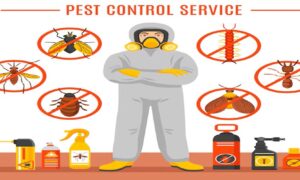Blog Introduction: Pests can be a huge problem for your lawn and garden, but the good news is that there are ways to manage them. There are several different types of pests that can affect your lawn, and understanding which ones you have and how to control them is the key to maintaining a healthy yard. This guide will discuss the role pests play in your lawn, examples of common pests, as well as strategies for controlling and preventing pest infestations. Consult with a pest control company for more information.
What do Pests do to Lawns?
Pests can cause significant damage to your lawn if they are left unchecked. They feed on plants and grasses, leaving behind bare patches which can weaken the structure of the soil. Some pests also carry diseases or parasites that can harm other plants in your garden or spread to humans. Commonly found pests include beetles, caterpillars, aphids, slugs, snails, grubs and moles.
Examples of Pests
- Beetles are one of the most common pests found in lawns. They often feed on flowers and foliage as well as grass blades, leaving behind large holes in their wake.
- Caterpillars are another common pest; they usually feed on leaves but may also chew through stems or fruit trees.
- Aphids are small insects that suck the sap from plants; they can cause wilting or discoloration of leaves.
- Slugs and snails eat vegetation and leave behind silvery trails on pathways or bare patches in turfgrass.
- Grubs live underground and feed on plant roots while moles create tunnels underneath your lawn that disturb its structure and appearance.
How to Control Them
The best way to keep pest infestations at bay is by implementing an integrated pest management system (IPM).
This involves using natural methods such as introducing beneficial bugs like ladybugs or praying mantises that prey on harmful insects; setting up physical barriers like fences around vulnerable areas; avoiding overwatering; promoting healthy soil with organic matter like compost; eliminating hiding spots like wood piles or debris piles near your home; regularly checking for signs of infestation; monitoring temperatures during seasonal changes; rotating crops annually; promptly removing any affected plants from your garden; and applying chemical treatments when needed (though these should always be used as a last resort).
As a homeowner, keeping your lawn free from pests and insects is crucial to maintaining its beauty and health. That’s why “A Guide to Pest Control for Your Lawn” is an essential resource for anyone looking to protect their outdoor space. This comprehensive guide covers everything from identifying common pests like grubs, chinch bugs, and armyworms to natural remedies that can be used as alternative pest control measures. The keyword here is prevention; the guide emphasizes the importance of good lawn care practices such as regular mowing, proper irrigation techniques, and fertilization schedules that can help you avoid inviting unwanted guests onto your property in the first place. Additionally, it provides expert advice on choosing pesticides that are safe for the environment while still being effective at controlling specific types of pests. With this invaluable resource at hand, any homeowner can confidently tackle pest problems head-on while also keeping their lawn looking lush and healthy all year round!
Conclusion
In conclusion, it’s important to understand the role pests can play in damaging your lawn so you can take steps to prevent infestations before they begin. Knowing what kinds of pests you may have helps you come up with an effective plan for controlling them without causing further damage to your landscape. With patience and practice, you’ll soon be able to maintain a healthy yard free from pesky invaders!



































